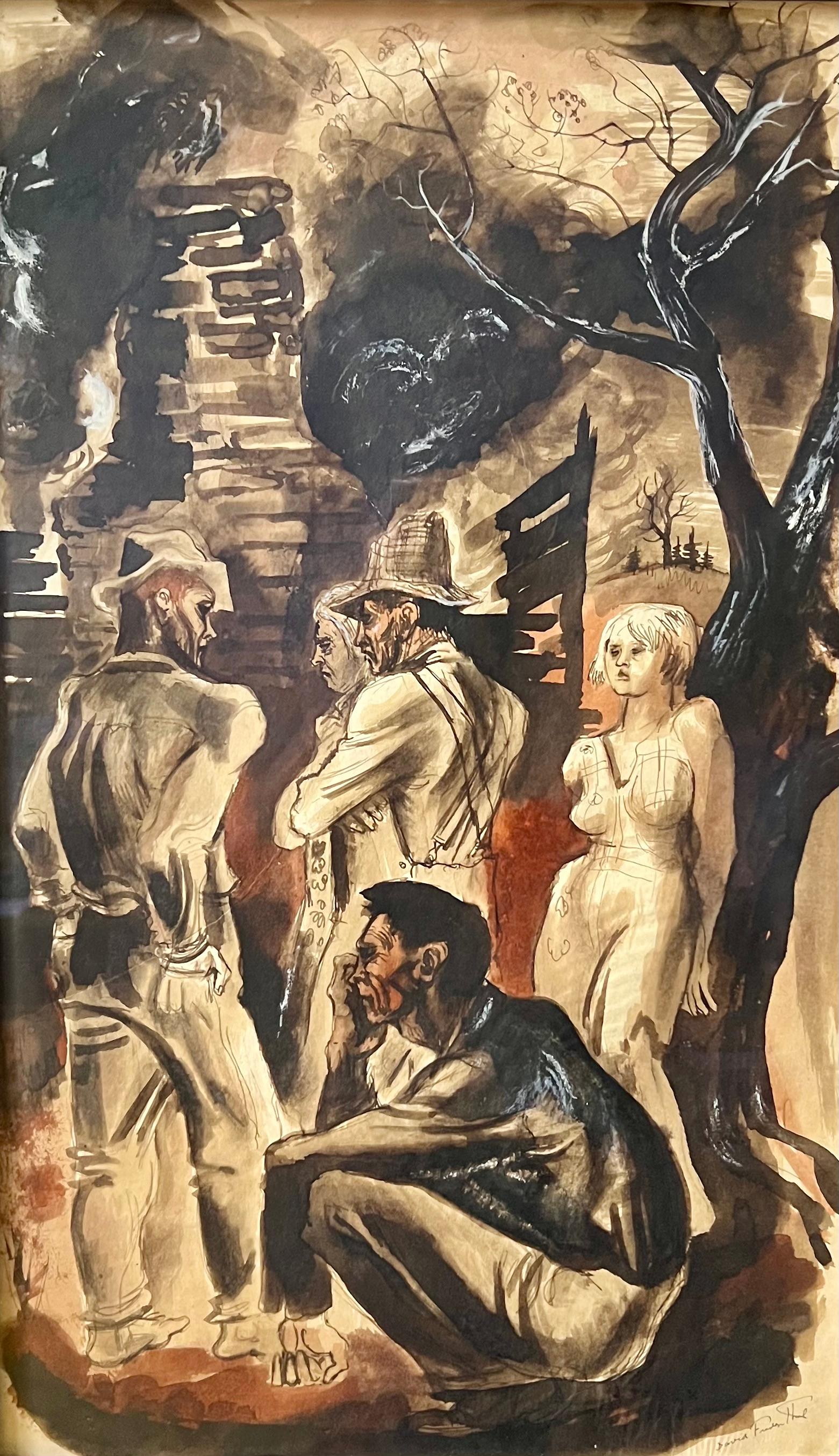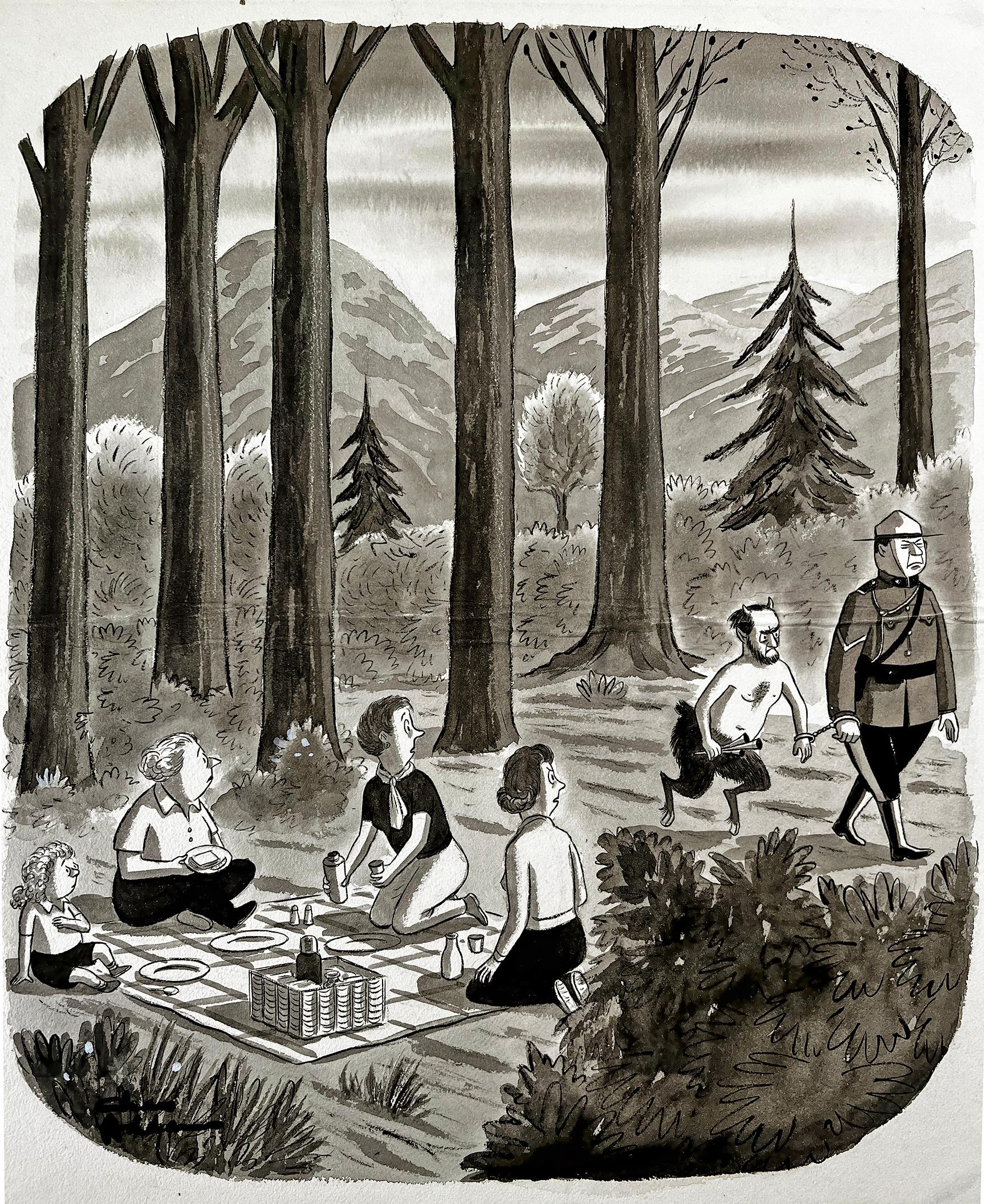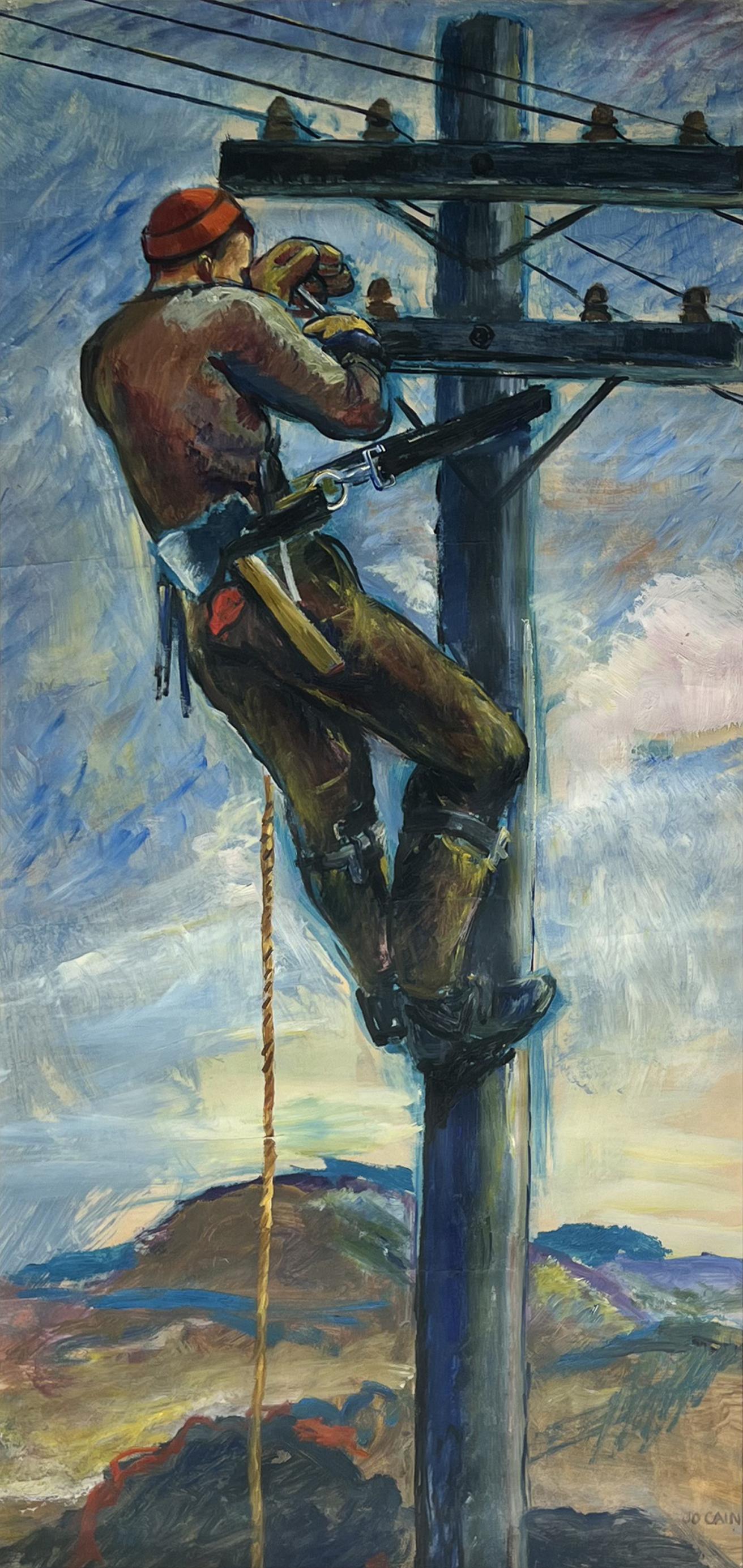Items Similar to TOBACCO ROAD Mid 20th Century Realism 1940 Drawing from the Novel WPA Literary 3
Want more images or videos?
Request additional images or videos from the seller
1 of 8
David FredenthalTOBACCO ROAD Mid 20th Century Realism 1940 Drawing from the Novel WPA Literary 31939
1939
About the Item
TOBACCO ROAD Mid 20th Century Realism 1940 Drawing from the Novel WPA Literary 3
10 1/2 x 6 (sight), Signed David Fredenthal lower right. Framed by Lowy.
Offered here is one of several original drawings by WPA artist David Fredenthal that were first published in the 1940 illustrated edition of the novel TOBACCO ROAD by Erskine Caldwell.
Background on the Drawing
Erskine Caldwell remarked, on seeing the work of David Fredenthal, 26-year-old painter: "That boy could draw my Tobacco Road people." A casual comment, it was enormously productive.
The young painter was just finishing a two-year Guggenhcim Fellowship, preceded by a year's study in Paris, two one-man shows at New York's Downtown Gallery, and a fellowship at the Cranbrook Academy near Detroit. He was out in Colorado Springs when he heard what Caldwell had said about him.
Fredenthal hadn't read Tobacco Road. He had not even seen the play - now breaking all records in its seventh year on Broadway. But he swapped a portrait for a second-hand Ford and headed East.
In New York he learned that Dnell, Sloan & Pearce were bringing out a deluxe edition of Tobacco Road. But he had no entrée to the publishers, and Caldwell, to his disappointment, was out of town. So he drove on to Georgia to have a look at the Tobacco Road people.
He found Dr. I. C. Caldwell, the author's father, in Wrens, Ga., going on his ministerial rounds among people like the Lesters. Fredenthal got a room from a couple who ran a 1-pump filling station—and stayed two months.
He is a direct and unaffected person, not a prober into social problems. He asked no questions - just looked. At night he stopped at the town's bar, sat at a corner table, and drew what he had seen that day: sick people, unable to mend because of lack of nourishment; an old palsied woman picking peas to get money for the medicine the doctor ordered: families housed five in a room - plus a cur dog or two; families at table; men skinning down a pig; women gathering fire woods; some just settin', or making away with a jug of corn.
These drawings he sent back to Caldwell. Caldwell turned them over to the publishers, who sent for the artist and ordered 40-odd pen and ink drawings and six in color to illustrate the text. When the publishers said some of the finished drawings were too raw—contained too many buttocks—Caldwell said: "Give the kid a free hand. He's seen it. He knows what he's drawing."
The publication of the new edition of Tobacco Road. on Nov. 8 is a moment of triumph for young Fredenthal. He grabbed the ball and ran off ahead of a field of Bentons and Woods and many bcttcr-known artist-illustrators.
Now he likes to illustrate books. Books about elemental people. He can draw from vivid memories: sailors on the Great Lakes, freighters, men on the Ford Plant assembly line, denizens of flop houses where he lived when distributing Christmas cards
for $4 a week. He can draw his fellow C.C.C. workers in the first gang to go out in '33 - laying lines, building roads and state parks, fighting fire.
Like most artists, Fredenthal is a hopelessly bad businessman and always broke. "Anyway", he says, "there's a regular pay check to be had from the army - if it has to come to that “
- Maude Riley
CUE - The Weekly Magazine of New York Life (vol. 9 #46, Nov. 1940)
David Fredenthal (1914 - 1958) was one ot America's most respected watercolor artists. He was famous tor his bold, intensely vigorous and complex paintings and drawings that expressed his deep feeling for excitement with life and living. He was a brilliant natural draftsman with a special gift for catching anything, physically and emotionally on the spot, and he never went anywhere without three or four loaded pens and a sketchbook in his pocket.
As part of the WPA project he executed a number of murals including Five large panels in fresco under the Federal Art Project in the Brodhead Naval Armory, Detroit, MI, 1937.
The Sports Pavilion on the Heinz Building of the New York World's Fair 1939. Some of his fresco and mural techniques were inspired by his friendship with Diego Rivera who had admired and encouraged him in the early1930's.
After he won a traveling scholarship to Europe from The Museum of Modern Art at age 19, he was the recipient of two Guggenheim grants in Painting. He had his first solo exhibition at the Downtown Gallery in New York in 1937 atage 23 and many others after that including the Whitney Museum of American Art in 1947.
Because of Fredenthal's prodigious drawing gifts, he was chosen by Erskine Caldwell to illustrate his novel “Tobacco Road” in 1940. He was a War Artist Correspondent for both the State Department (the European and Asian fronts) and Life magazine from 1943 to 1946 and his work was featured in Life Magazine regularly during the war and after until the end of his life.
Also featured in Life in 1956 were drawings that Fredenthal had vividly recorded on his sketch pad, of the entire filming of the movie, “The Pride and the Passion,” starring Cary Grant, Sophia Loren, and Frank Sinatra, along the treacherous mountain passes of Spain.
Though he was fiercely committed to an art that expressed deeply human social values and issues and was quite hostile to abstraction, he was friendly with a number of abstract artists such as David Smith, Ad Reinhardt, Philip Guston, Paul Feeley, and Herman Cherry and was very admired and respected by them as one of art history's great draftsmen.
- Creator:David Fredenthal (1914-1958, American)
- Creation Year:1939
- Dimensions:Height: 21 in (53.34 cm)Width: 16 in (40.64 cm)Depth: 2 in (5.08 cm)
- Medium:
- Movement & Style:
- Period:
- Condition:
- Gallery Location:New York, NY
- Reference Number:1stDibs: LU115629761682
About the Seller
5.0
Platinum Seller
These expertly vetted sellers are 1stDibs' most experienced sellers and are rated highest by our customers.
Established in 2008
1stDibs seller since 2019
163 sales on 1stDibs
Typical response time: <1 hour
- ShippingRetrieving quote...Ships From: New York, NY
- Return PolicyA return for this item may be initiated within 3 days of delivery.
More From This SellerView All
- TOBACCO ROAD Mid 20th Century Realism 1940 Drawing from the Novel WPA Literary 2By David FredenthalLocated in New York, NYTOBACCO ROAD Mid 20th Century Realism 1940 Drawing from the Novel WPA Literary 2 10 1/2 x 6 (sight), Signed David Fredenthal lower right. Framed by Lowy....Category
1930s American Realist Figurative Drawings and Watercolors
MaterialsPaper, Ink, Watercolor
- "Tobacco Road" Mid 20th Century Realism 1940 Drawing from the Novel WPA LiteraryBy David FredenthalLocated in New York, NY"Tobacco Road" Mid 20th Century Realism 1940 Drawing from the Novel WPA Literary 19 1/4 x 11 1/2 (sight), Signed David Fredenthal lower right. Framed by ...Category
1930s American Realist Figurative Drawings and Watercolors
MaterialsPaper, Ink, Watercolor
- Man Working Mid 20th Century American Scene Social Realism Industrial WPA ModernBy Jo CainLocated in New York, NYMan Working Mid 20th Century American Scene Social Realism Industrial WPA Modern Jo Cain (1904 - 2003) Telephone Pole Worker 38 1/4 x 18 1/2 inches Oil on pap...Category
1930s American Realist Figurative Drawings and Watercolors
MaterialsPaper, Gouache
- Answering the Door Early 20th Century w/c Fauvism Social Realism American SceneBy Stuart DavisLocated in New York, NYAnswering the Door Early 20th Century w/c Fauvism Social Realism American Scene Note: We have three similar in style works from 1911 available now on 1stDibs. All are framed identi...Category
1910s American Realist Figurative Drawings and Watercolors
MaterialsPaper, Watercolor
- Two Men on a Street Early 20th Century w/c Fauvism Social Realism American SceneBy Stuart DavisLocated in New York, NYTwo Men on a Street Early 20th Century w/c Fauvism Social Realism American Scene Note: We have three similar in style works from 1911 available now on 1stDibs. All are framed identi...Category
Early 1900s American Realist Figurative Drawings and Watercolors
MaterialsPaper, Watercolor
- "Backyards" Early 20th Century Watercolor Fauvism Social Realism American SceneBy Stuart DavisLocated in New York, NY"Backyards" Early 20th Century Watercolor Fauvism Social Realism American Scene Note: We have three similar in style works from 1911 available now on 1stDibs. All are framed identic...Category
1910s American Realist Figurative Drawings and Watercolors
MaterialsPaper, Watercolor
You May Also Like
- Nonconformist Removed by the State. Satyr / Pan MythologyLocated in Miami, FLThis cartoon by Charles Addams is generations ahead of its time. To get the punch line, you need to know the meaning of a Satyr or Pan. Satyr: Part man and part beast. - A male nature spirit with ears and a tail resembling those of a horse, as well as a permanent, exaggerated permanent erection. Early artistic representations sometimes include horse-like legs; Satyrs were characterized by their vulgar, indecent ribaldry, and were rowdy lovers of wine, music, dancing, and women. They inhabited remote locales, such as woodlands, and they often attempted to seduce or rape nymphs and mortal women alike. It's prudish 1950s America, where TV programs show husband and wife sleeping in separate beds. The discussion and representation of sex was repressed. To make a bold statement about censorship and the uncompromising moral climate of the time, Addams uses a reference from the mythical world to make a statement about the real world. In doing so, he anticipates the sexual revolution of the late 1960s and 1970s. The satyr/pan symbolizes nonconformistism. He has his own earthy customs, attitudes, and ideas. Because of that is being handcuffed and formally taken away by the state whose goal is to repress natural erotic fun and frolic that is ubiquitous in todays society. A proper and perfectly pressed Park Ranger cleans out a lustful undesirable from pristine woodlands. With startled expressions, a vulnerable family of correct women witness the event as they are about to have a picnic. The Satyr grasps his Pipes of Pan just over his crotch. The background is populated by phallic symbols. This is one a the rare instances where Addams address the issue of sex. The Ranger is a dead ringer as a self portrait of Addams. Original illustration for a cartoon, showing a uniformed ranger leading away a manacled satyr, in front of a startled picnic party. Ink and grisaille wash on Whatman cold press illustration board, signed "Chas Addams...Category
1950s American Realist Figurative Drawings and Watercolors
MaterialsWatercolor, Ink
- Environmental Prognostication Coil Narrative "Homo Sapiens R.I.P."Located in Miami, FL"They paved paradise and put up a parking lot," Joni Mitchell said. - - Created in 1969, at the dawn of the American environmental movement, artist Richard Erdoes draws a sequential narrative in the form of a coil. From inception to destruction, it illustrates a list of things that humans are doing to destroy the world we live in. The work was commissioned for school-age humans and executed in a whimsically comic way. Yet the underlying narrative is sophisticated and foreshadows a world that could be on the brink of ecological disaster. Graphically and conceptually, this work exhibits an endless amount of creativity and Erdoes cartoony style is one to fall in love with. Signed lower right. Unframed 12.4 inches Width: 12.85 inches Height is the live area. Board is 16x22 inches. Richard Erdoes (Hungarian Erdős, German Erdös; July 7, 1912 – July 16, 2008) was an American artist, photographer, illustrator and author. Early life Erdoes was born in Frankfurt,to Maria Josefa Schrom on July 7, 1912. His father, Richárd Erdős Sr., was a Jewish Hungarian opera singer who had died a few weeks earlier in Budapest on June 9, 1912.After his birth, his mother lived with her sister, the Viennese actress Leopoldine ("Poldi") Sangora,He described himself as "equal parts Austrian, Hungarian and German, as well as equal parts Catholic, Protestant and Jew..."[4] Career He was a student at the Berlin Academy of Art in 1933, when Adolf Hitler came to power. He was involved in a small underground paper where he published anti-Hitler political cartoons which attracted the attention of the Nazi regime. He fled Germany with a price on his head. Back in Vienna, he continued his training at the Kunstgewerbeschule, now the University of Applied Arts, Vienna.[5] He also wrote and illustrated children's books and worked as a caricaturist for Tag and Stunde, anti-Nazi newspapers. After the Anschluss of Austria in 1938 he fled again, first to Paris, where he studied at the Academie de la Grande Chaumiere, and then London, England before journeying to the United States. He married his first wife, fellow artist Elsie Schulhof (d. xxxx) in London, shortly before their arrival in New York City. In New York City, Erdoes enjoyed a long career as a commercial artist, and was known for his highly detailed, whimsical drawings. He created illustrations for such magazines as Stage, Fortune, Pageant, Gourmet, Harper's Bazaar, Sports Illustrated, The New York Times, Time, National Geographic and Life Magazine, where he met his second wife, Jean Sternbergh (d. 1995) who was an art director there. The couple married in 1951 and had three children.[6] Erdoes also illustrated many children's books. An assignment for Life in 1967 took Erdoes to the Pine Ridge Indian Reservation for the first time, and marked the beginning of the work for which he would be best known. Erdoes was fascinated by Native American culture, outraged at the conditions on the reservation and deeply moved by the Civil Rights Movement that was raging at the time. He wrote histories, collections of Native American stories...Category
1960s American Realist Landscape Drawings and Watercolors
MaterialsInk, Gouache, Illustration Board
- "Sleigh Ride, Winter, " Fletcher Martin, Woodstock, Holiday Scene IllustrationBy Fletcher MartinLocated in New York, NYFletcher Martin (1904 - 1979) Sleigh Ride, Woodstock, New York circa 1955 Watercolor on paper 14 x 11 inches Signed lower right Provenance: James Cox Galler...Category
1950s American Realist Landscape Drawings and Watercolors
MaterialsPaper, Watercolor
- King Street, Troy (Modern Realist Cityscape in Black & White Watercolor)By Scott Nelson FosterLocated in Hudson, NYwatercolor on paper 9 x 11 inches 17 x 21 x 1 inches, brown wood artist made frame, white mat This photo-realist cityscape of Albany, NY was painted with black and white watercolo...Category
2010s American Realist Landscape Drawings and Watercolors
MaterialsArchival Paper, Watercolor
- Tourists Viewing the Temple of Karnak, EgyptBy Eleanor Parke CustisLocated in New York, NYEleanor Park Custis painted scenes as varied as the artist's travels: from her hometown of Washington, D.C., to the coastal towns of New England; from the prosperous fishing villages of Brittany, to Venice and the mountain villages and lakes of northern Italy. While Custis's subjects are diverse, her style is consistent and distinctive throughout this body of work. Her use of flat areas of color delineated by dark contours is reminiscent of the aesthetics of woodblock printing. Like many artists of the day, she was profoundly influenced by Japanese woodblock prints, and her adaptation of the aesthetic by 1924 led to her most productive artistic period. Eleanor Custis hailed from a socially prominent Washington, D.C., family. She was distantly related to Martha Custis Washington, America's first First Lady. Custis began three years of formal art training in the autumn of 1915 at the Corcoran School of Art in Washington, and was guided and inspired by Impressionist artist Edmund C. Tarbell, one of the Ten American Painters, who became the Corcoran School's principal in 1918. Custis exhibited widely in many of the Washington art societies and clubs for much of her career. She was also a frequent exhibitor at the Grand Central Art Galleries in New York City; her last one-woman show there was in April 1945. Custis's mature style emerged in scenes of the streets, wharves, and drydocks of seacoast villages from Maine to Massachusetts, which she visited during the summers of 1924 and 1925. She was working in Gloucester, Massachusetts in August 1924, and painted several gouaches of the town's wharves and winding streets, including In Gloucester Harbor and At the Drydock, Gloucester. During her stay, Custis may have met Jane Peterson or at least must have seen her work, the best of which was executed in Gloucester during the preceding ten years. The similarity between their styles is unmistakable, but, while it may be tempting to suggest that Custis was influenced by Peterson during her summer in Gloucester, the connection between their work is probably more a case of shared aesthetics and common European influences. Custis expanded her subject repertoire with three trips to Europe between 1926 and 1929, and was inspired by the Old World charm of Holland, northern France, Switzerland, and Italy, leading to such works as New Kirk, Delft, Holland, Market Day in Quimper, At the Foot of the Matterhorn, and The Town Square, Varenna. A Mediterranean cruise in 1934 introduced her to the Near East, and the bustling, colorful streets and bazaars of Cairo, captured in works like A Street in Cairo, Egypt and A Moroccan Jug...Category
20th Century American Realist Landscape Drawings and Watercolors
MaterialsPaper, Gouache
- Mid-Century Hillside Trees Landscape Watercolor (unfinished)By Joseph YeagerLocated in Soquel, CABeautiful mid-century landscape watercolor with a tall, stately tree in the foreground, its many forking branches depicted with exceptional detail, and a verdant background of rollin...Category
Mid-20th Century American Realist Landscape Drawings and Watercolors
MaterialsPaper, Watercolor





